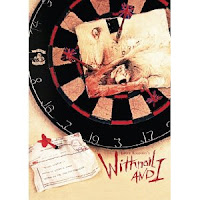
 Our Number One winner for 2011, with 9 votes:
Our Number One winner for 2011, with 9 votes:
Tom Waits –
Bad As Me
Paul E. sez: “The poet of the back alley returns with his first album of new material in quite some time. There is enough clanking, barking and yowling to satisfy fans of his modern style, and the songwriting and lyrics are as intelligent and poignant as they have ever been. He is a mystery: the less he cares about public expectation, the more the public loves him.”
Our Number Two placer for 2011, with 8 votes:
Wooden Shjips – West
Adam sez: “Wooden Shjips are the kings of the new psychedelia. Hailing from San Francisco (of course) their 2011 release West has shorter songs than previous releases but still plenty of guitar fuzz and trippy atmospherics. Perfect for your next Freak-Out or Be-In.”
Our Number Three shower for 2011, with 6 votes:
Beach Boys – Smile Sessions
Ben S. sez: “Easily the most anticipated album of my lifetime and beyond. After 45 years, the original Smile recordings got to see light of day in a finished (as possible) form, and showed that not much has really changed in that time. Brian Wilson, Van Dyke Parks and gang had a mind-expanding vision that is still vital, and even visionary these days. Available in die-hard deluxe and regular casual editions, every fan of 60s pop, psychedelia and anything outside of the box need to pay attention to this.”
Our Number Four mentions for 2011, with 5 votes each:
Destroyer – Kaputt
Christian sez: “New Romantic pop lushness with soft horns and dreamy synths. If you liked Frazier Chorus and Black, then this is right up your alley. ”
 PJ Harvey – Let England Shake
PJ Harvey – Let England Shake
Christian sez: “If you are not a fan already of PJ Harvey, then this is the kool-aid you are looking for. Harvey is known for her soul-baring, gut-wrenching howl, so when she decides to come at you soft and sweet, your ears perk up. Don’t let the sweetness fool you – this album is fierce.”
Our Number Five mentions for 2011, with 4 votes each:
Dengue Fever – Cannibal Courtship
Chris B sez: “Cambodian Pop fueled Beach rock fun with great female dominated vocals and a variety of beats that have you humming along in no time!”
Esben & the Witch – Violet Cries
Brian sez: “This year saw several excellent Goth-styled releases, and the debut by British trio Esben & the Witch is at the top. Their music is both ethereal and engaging, and stunning vocalist Rachel Davies is a true presence. File this proudly next to Bauhaus and Siouxsie.”
Martyn – Ghost People
Peter Black sez: “Los Angeles based Brainfeeder records released Martyn’s sophomore album near the end of 2011 and it's a stunning addition to their current catalog as well as a perfect of summary of the post-dubstep scene. Representative sounds touch down across the spectrum from West London style 2-Step, dark Croydon rude-boy Dubstep, Drum & Bass, gritty mechanical Detroit Techno and expertly programmed deep house. This album presents a strong experimental edge that expresses Martyn's futurist vision while simultaneously satisfying the listener with repeated exploration. Highly recommend.”
Raphael Saadiq – Stone Rollin’
Ben S. sez: “In the tradition of great artists, Raphael Saadiq follows up a stone cold classic The Way I See It with an adventurous, idiosyncratic gem. Instead of creating a formulaic clone, Raphael goes beyond the classic soul territory that has served him so well, and dishes up lashings of psychedelia, Prog rock, Gospel and Blaxploitation funk. A riotous success, Stone Rollin' is even better than his previous best.”
 St. Vincent – Strange Mercy
St. Vincent – Strange Mercy
Doug sez: “St. Vincent continues in the tradition of strong artists such as PJ Harvey, Patti Smith, and Joni Mitchell. All these women have the ability to write songs that are catchy and artistically detailed. These may ring as heavy names to be compared to, but over the course of three albums St. Vincent has shown strong vocal abilities, shredding guitar chops, and the ability to write a diverse set of intelligent avant pop songs. Strange Mercy, the latest, is a definite treat and check out Youtube or her website for covers ranging from Tom Waits to the Beatles. When I saw her in Denver I was blown away by a solo cover of Nico's ‘These Days’ at the Bluebird Theatre.”
Kurt Vile – Smoke Ring For My Halo
Paul E. sez: “Vile plays rock with immediacy and guts, and his attention to sonic detail and vintage equipment lends his psychedelic compositions an air of authenticity. He is creating an impressive body of work, and Smoke Ring might be his finest yet. Pick up the deluxe edition which contains another EP with 6 more songs including an excellent cover of Springsteen’s ‘Downbound Train.’”
Our Number Six mentions for 2011, with 3 votes each:
Battles – Gloss Drop
Kate Bush – 50 Words For Snow
Danger Mouse/Daniele Luppi – Rome
Miles Davis – Live in Europe 1967: The Bootleg Series Vol. 1
Devotchka – 100 Lovers
Lady Gaga – Born This Way
Little Dragon – Ritual Union
Lou Reed/Metallica – Lulu
Dex Romweber – Is That You In the Blue?
Talk Talk – Laughing Stock (reissue)
Tame Impala – Innerspeaker
Tune-Yards – Whokill
Tyler the Creator – Goblin
Gillian Welch – The Harrow and the Harvest
 Our Number Seven mentions for 2011, with 2 votes each:
Our Number Seven mentions for 2011, with 2 votes each:
Sorry Bamba – Vol. 1 1970-79
James Blake – James Blake
Blitzen Trapper – American Goldwing
Clap Your Hands Say Yeah – Hysterical
Cults – Cults
Cut Copy – Zonoscope
Dirty Projectors/Bjork – Mount Wittenberg Orca
EMA – Past Life Martyred Saints
Brian Eno – Drums Before the Bells
Feelies – Here Before
Fleet Foxes – Helplessness Blues
Francyst – The Bob Special Remix
Gang Gang Dance – Eye Contact
Merle Haggard – Working in Tennessee
Hail Mary Mallon (Aesop Rock & Rob Sonic) – Are You Gonna Eat That?
Black Joe Lewis – Scandalous
Man Man – Life Fantastic
Mastodon – The Hunter
Onemanna – Docking Your Mind With Dirty Thoughts
Panda Bear – Tomboy
Radiohead – The King of Limbs
SBTRKT – SBTRKT
Sigur Ros – Inni
Paul Simon – So Beautiful or So What
Skinny Puppy – Handover
Smiths – Complete
Snake Rattle Rattle Snake – Sineater
Britney Spears – Femme Fatale
Stepkids – Stepkids
White Hills – H-p1
Wilco – The Whole Love
Wild Flag – Wild Flag
Lucinda Williams – Blessed
Zomby – Dedication
 Richard E. Grant is utterly mesmerizing as Withnail, a dementedly erudite degenerate, prone to manic bouts of drug and alcohol consumption and spouting delightful, crude Wilde-isms. It's a role of a lifetime and Grant rightfully shot to stardom upon the film's release. His roommate, Marwood (the titular I), played by Paul McGann, is the sweeter and not so hopeless of the pair. It has often been said that this film is (writer/director) Bruce Robinson's semi-autobiographical account of the Aquarian age twilight, and it is easy to see given the level of nostalgic detail. I've always assumed, given the film's title, that indeed Marwood is Robinson, adding yet another layer of pathos.
Richard E. Grant is utterly mesmerizing as Withnail, a dementedly erudite degenerate, prone to manic bouts of drug and alcohol consumption and spouting delightful, crude Wilde-isms. It's a role of a lifetime and Grant rightfully shot to stardom upon the film's release. His roommate, Marwood (the titular I), played by Paul McGann, is the sweeter and not so hopeless of the pair. It has often been said that this film is (writer/director) Bruce Robinson's semi-autobiographical account of the Aquarian age twilight, and it is easy to see given the level of nostalgic detail. I've always assumed, given the film's title, that indeed Marwood is Robinson, adding yet another layer of pathos.




































